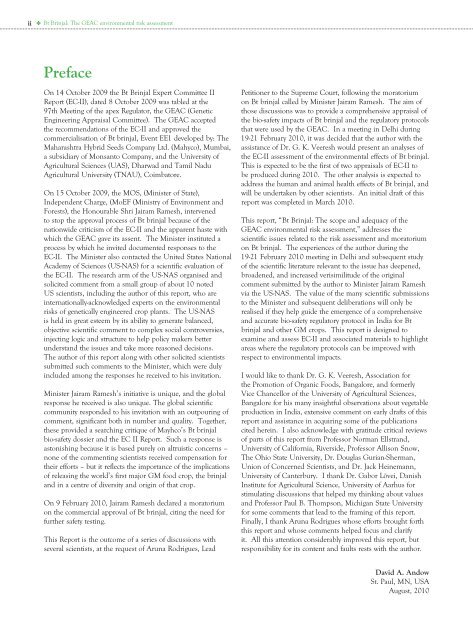Bt Brinjal The scope and adequacy of the GEAC environmental risk assessment
Bt Brinjal: The scope and adequacy of the GEAC ... - Down To Earth
Bt Brinjal: The scope and adequacy of the GEAC ... - Down To Earth
- No tags were found...
You also want an ePaper? Increase the reach of your titles
YUMPU automatically turns print PDFs into web optimized ePapers that Google loves.
ii <strong>Bt</strong> <strong>Brinjal</strong>: <strong>The</strong> <strong>GEAC</strong> <strong>environmental</strong> <strong>risk</strong> <strong>assessment</strong>PrefaceOn 14 October 2009 <strong>the</strong> <strong>Bt</strong> <strong>Brinjal</strong> Expert Committee IIReport (EC-II), dated 8 October 2009 was tabled at <strong>the</strong>97th Meeting <strong>of</strong> <strong>the</strong> apex Regulator, <strong>the</strong> <strong>GEAC</strong> (GeneticEngineering Appraisal Committee). <strong>The</strong> <strong>GEAC</strong> accepted<strong>the</strong> recommendations <strong>of</strong> <strong>the</strong> EC-II <strong>and</strong> approved <strong>the</strong>commercialisation <strong>of</strong> <strong>Bt</strong> brinjal, Event EE1 developed by: <strong>The</strong>Maharashtra Hybrid Seeds Company Ltd. (Mahyco), Mumbai,a subsidiary <strong>of</strong> Monsanto Company, <strong>and</strong> <strong>the</strong> University <strong>of</strong>Agricultural Sciences (UAS), Dharwad <strong>and</strong> Tamil NaduAgricultural University (TNAU), Coimbatore.On 15 October 2009, <strong>the</strong> MOS, (Minister <strong>of</strong> State),Independent Charge, (MoEF (Ministry <strong>of</strong> Environment <strong>and</strong>Forests), <strong>the</strong> Honourable Shri Jairam Ramesh, intervenedto stop <strong>the</strong> approval process <strong>of</strong> <strong>Bt</strong> brinjal because <strong>of</strong> <strong>the</strong>nationwide criticism <strong>of</strong> <strong>the</strong> EC-II <strong>and</strong> <strong>the</strong> apparent haste withwhich <strong>the</strong> <strong>GEAC</strong> gave its assent. <strong>The</strong> Minister instituted aprocess by which he invited documented responses to <strong>the</strong>EC-II. <strong>The</strong> Minister also contacted <strong>the</strong> United States NationalAcademy <strong>of</strong> Sciences (US-NAS) for a scientific evaluation <strong>of</strong><strong>the</strong> EC-II. <strong>The</strong> research arm <strong>of</strong> <strong>the</strong> US-NAS organised <strong>and</strong>solicited comment from a small group <strong>of</strong> about 10 notedUS scientists, including <strong>the</strong> author <strong>of</strong> this report, who areinternationally-acknowledged experts on <strong>the</strong> <strong>environmental</strong><strong>risk</strong>s <strong>of</strong> genetically engineered crop plants. <strong>The</strong> US-NASis held in great esteem by its ability to generate balanced,objective scientific comment to complex social controversies,injecting logic <strong>and</strong> structure to help policy makers betterunderst<strong>and</strong> <strong>the</strong> issues <strong>and</strong> take more reasoned decisions.<strong>The</strong> author <strong>of</strong> this report along with o<strong>the</strong>r solicited scientistssubmitted such comments to <strong>the</strong> Minister, which were dulyincluded among <strong>the</strong> responses he received to his invitation.Minister Jairam Ramesh’s initiative is unique, <strong>and</strong> <strong>the</strong> globalresponse he received is also unique. <strong>The</strong> global scientificcommunity responded to his invitation with an outpouring <strong>of</strong>comment, significant both in number <strong>and</strong> quality. Toge<strong>the</strong>r,<strong>the</strong>se provided a searching critique <strong>of</strong> Mayhco’s <strong>Bt</strong> brinjalbio-safety dossier <strong>and</strong> <strong>the</strong> EC II Report. Such a response isastonishing because it is based purely on altruistic concerns –none <strong>of</strong> <strong>the</strong> commenting scientists received compensation for<strong>the</strong>ir efforts – but it reflects <strong>the</strong> importance <strong>of</strong> <strong>the</strong> implications<strong>of</strong> releasing <strong>the</strong> world’s first major GM food crop, <strong>the</strong> brinjal<strong>and</strong> in a centre <strong>of</strong> diversity <strong>and</strong> origin <strong>of</strong> that crop.On 9 February 2010, Jairam Ramesh declared a moratoriumon <strong>the</strong> commercial approval <strong>of</strong> <strong>Bt</strong> brinjal, citing <strong>the</strong> need forfur<strong>the</strong>r safety testing.This Report is <strong>the</strong> outcome <strong>of</strong> a series <strong>of</strong> discussions withseveral scientists, at <strong>the</strong> request <strong>of</strong> Aruna Rodrigues, LeadPetitioner to <strong>the</strong> Supreme Court, following <strong>the</strong> moratoriumon <strong>Bt</strong> brinjal called by Minister Jairam Ramesh. <strong>The</strong> aim <strong>of</strong>those discussions was to provide a comprehensive appraisal <strong>of</strong><strong>the</strong> bio-safety impacts <strong>of</strong> <strong>Bt</strong> brinjal <strong>and</strong> <strong>the</strong> regulatory protocolsthat were used by <strong>the</strong> <strong>GEAC</strong>. In a meeting in Delhi during19-21 February 2010, it was decided that <strong>the</strong> author with <strong>the</strong>assistance <strong>of</strong> Dr. G. K. Veeresh would present an analyses <strong>of</strong><strong>the</strong> EC-II <strong>assessment</strong> <strong>of</strong> <strong>the</strong> <strong>environmental</strong> effects <strong>of</strong> <strong>Bt</strong> brinjal.This is expected to be <strong>the</strong> first <strong>of</strong> two appraisals <strong>of</strong> EC-II tobe produced during 2010. <strong>The</strong> o<strong>the</strong>r analysis is expected toaddress <strong>the</strong> human <strong>and</strong> animal health effects <strong>of</strong> <strong>Bt</strong> brinjal, <strong>and</strong>will be undertaken by o<strong>the</strong>r scientists. An initial draft <strong>of</strong> thisreport was completed in March 2010.This report, “<strong>Bt</strong> <strong>Brinjal</strong>: <strong>The</strong> <strong>scope</strong> <strong>and</strong> <strong>adequacy</strong> <strong>of</strong> <strong>the</strong><strong>GEAC</strong> <strong>environmental</strong> <strong>risk</strong> <strong>assessment</strong>,” addresses <strong>the</strong>scientific issues related to <strong>the</strong> <strong>risk</strong> <strong>assessment</strong> <strong>and</strong> moratoriumon <strong>Bt</strong> brinjal. <strong>The</strong> experiences <strong>of</strong> <strong>the</strong> author during <strong>the</strong>19-21 February 2010 meeting in Delhi <strong>and</strong> subsequent study<strong>of</strong> <strong>the</strong> scientific literature relevant to <strong>the</strong> issue has deepened,broadened, <strong>and</strong> increased verisimilitude <strong>of</strong> <strong>the</strong> originalcomment submitted by <strong>the</strong> author to Minister Jairam Rameshvia <strong>the</strong> US-NAS. <strong>The</strong> value <strong>of</strong> <strong>the</strong> many scientific submissionsto <strong>the</strong> Minister <strong>and</strong> subsequent deliberations will only berealised if <strong>the</strong>y help guide <strong>the</strong> emergence <strong>of</strong> a comprehensive<strong>and</strong> accurate bio-safety regulatory protocol in India for <strong>Bt</strong>brinjal <strong>and</strong> o<strong>the</strong>r GM crops. This report is designed toexamine <strong>and</strong> assess EC-II <strong>and</strong> associated materials to highlightareas where <strong>the</strong> regulatory protocols can be improved withrespect to <strong>environmental</strong> impacts.I would like to thank Dr. G. K. Veeresh, Association for<strong>the</strong> Promotion <strong>of</strong> Organic Foods, Bangalore, <strong>and</strong> formerlyVice Chancellor <strong>of</strong> <strong>the</strong> University <strong>of</strong> Agricultural Sciences,Bangalore for his many insightful observations about vegetableproduction in India, extensive comment on early drafts <strong>of</strong> thisreport <strong>and</strong> assistance in acquiring some <strong>of</strong> <strong>the</strong> publicationscited herein. I also acknowledge with gratitude critical reviews<strong>of</strong> parts <strong>of</strong> this report from Pr<strong>of</strong>essor Norman Ellstr<strong>and</strong>,University <strong>of</strong> California, Riverside, Pr<strong>of</strong>essor Allison Snow,<strong>The</strong> Ohio State University, Dr. Douglas Gurian-Sherman,Union <strong>of</strong> Concerned Scientists, <strong>and</strong> Dr. Jack Heinemann,University <strong>of</strong> Canterbury. I thank Dr. Gabor Lövei, DanishInstitute for Agricultural Science, University <strong>of</strong> Aarhus forstimulating discussions that helped my thinking about values<strong>and</strong> Pr<strong>of</strong>essor Paul B. Thompson, Michigan State Universityfor some comments that lead to <strong>the</strong> framing <strong>of</strong> this report.Finally, I thank Aruna Rodrigues whose efforts brought forththis report <strong>and</strong> whose comments helped focus <strong>and</strong> clarifyit. All this attention considerably improved this report, butresponsibility for its content <strong>and</strong> faults rests with <strong>the</strong> author.David A. AndowSt. Paul, MN, USAAugust, 2010











